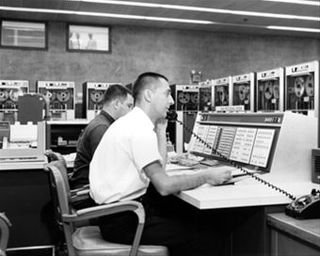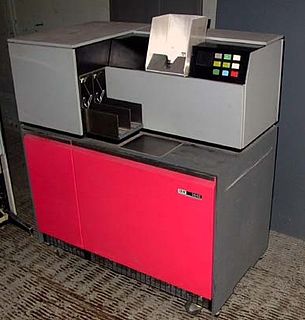
The IBM 704, introduced by IBM in 1954, is the first mass-produced computer with floating-point arithmetic hardware. The IBM 704 Manual of operation states:
The type 704 Electronic Data-Processing Machine is a large-scale, high-speed electronic calculator controlled by an internally stored program of the single address type.

The IBM 1620 was announced by IBM on October 21, 1959, and marketed as an inexpensive "scientific computer". After a total production of about two thousand machines, it was withdrawn on November 19, 1970. Modified versions of the 1620 were used as the CPU of the IBM 1710 and IBM 1720 Industrial Process Control Systems
The IBM 1401 is a variable wordlength decimal computer that was announced by IBM on October 5, 1959. The first member of the highly successful IBM 1400 series, it was aimed at replacing unit record equipment for processing data stored on punched cards and at providing peripheral services for larger computers. The 1401 is considered to be the Model-T Ford of the computer industry, because it was mass-produced and because of its sales volume. Over 12,000 units were produced and many were leased or resold after they were replaced with newer technology. The 1401 was withdrawn on February 8, 1971.

The IBM System/3 was an IBM midrange computer introduced in 1969, and marketed until 1985. It was produced by IBM Rochester in Minnesota as a low-end business computer aimed at smaller organizations that still used IBM 1400 series computers or unit record equipment. The first member of what IBM refers to as their "midrange" line, it also introduced the RPG II programming language.
IBSYS is the discontinued tape-based operating system that IBM supplied with its IBM 7090 and IBM 7094 computers. A similar operating system, also called IBSYS, was provided with IBM 7040 and IBM 7044 computers. IBSYS was based on FORTRAN Monitor System (FMS) and SHARE Operating System.

From the invention of computer programming languages up to the mid-1970s, most computer programmers created, edited and stored their programs line by line on punched cards.
Request price quotation or RPQ is a long-standing IBM designation for a product or component that is potentially available, but that is not on the "standard" price list. Typical RPQ offerings are custom interfaces, hardware modifications, research or experimental systems, or variable-cost items. In the days of IBM's large mainframes, e.g. the System/360 and System/370 series, many unusual features were flagged as "RPQ".

The IBM 7080 was a variable word length BCD transistor computer in the IBM 700/7000 series commercial architecture line, introduced in August 1961, that provided an upgrade path from the vacuum tube IBM 705 computer.
The IBM 2780 and the IBM 3780 are devices developed by IBM to perform Remote Job Entry (RJE) functions. They communicate with the mainframe via Binary Synchronous Communications.

IBM 1050 Data Communications System is a computer terminal subsystem to send data to and receive data from another 1050 subsystem or IBM computer in the IBM 1400, IBM 7000 or System/360 series. It first became available in 1963 and was used widely during the 1960s. The 1052 Printer-Keyboard was also the basis for the 1052-7 console Printer-Keyboard used on small and medium S/360 processors.
DAC-1, for Design Augmented by Computer, was one of the earliest graphical computer aided design systems. Developed by General Motors, IBM was brought in as a partner in 1960 and the two developed the system and released it to production in 1963. It was publicly unveiled at the Fall Joint Computer Conference in Detroit 1964. GM used the DAC system, continually modified, into the 1970s when it was succeeded by CADANCE.

A computer punched card reader or just computer card reader is a computer input device used to read computer programs in either source or executable form and data from punched cards. A computer card punch is a computer output device that punches holes in cards. Sometimes computer punch card readers were combined with computer card punches and, later, other devices to form multifunction machines. It is a input device and also an output device. Most early computers, such as the ENIAC, and the IBM NORC, provided for punched card input/output. Card readers and punches, either connected to computers or in off-line card to/from magnetic tape configurations, were ubiquitous through the mid-1970s.
BCD, also called alphanumeric BCD, alphameric BCD, BCD Interchange Code, or BCDIC, is a family of representations of numerals, uppercase Latin letters, and some special and control characters as six-bit character codes.












